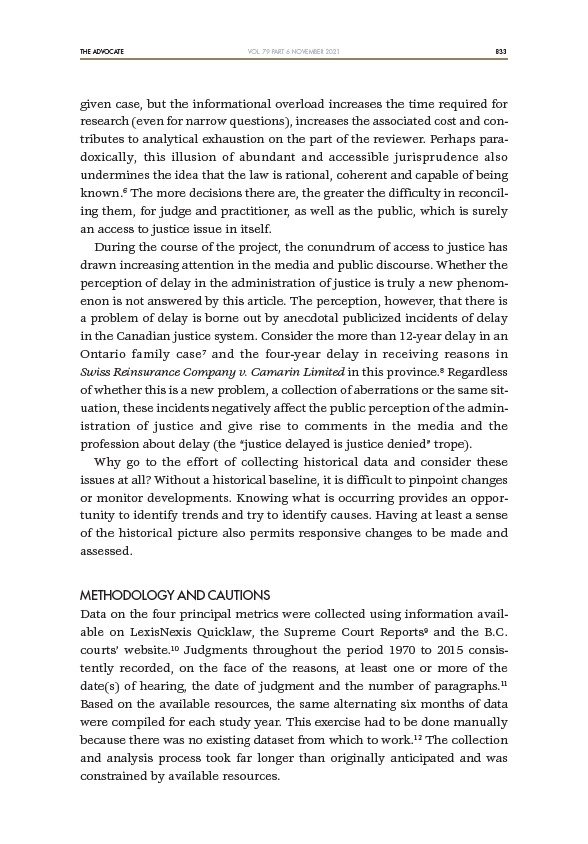
THE ADVOCATE 833
VOL. 79 PART 6 NOVEMBER 2021
given case, but the informational overload increases the time required for
research (even for narrow questions), increases the associated cost and contributes
to analytical exhaustion on the part of the reviewer. Perhaps paradoxically,
this illusion of abundant and accessible jurisprudence also
undermines the idea that the law is rational, coherent and capable of being
known.6 The more decisions there are, the greater the difficulty in reconciling
them, for judge and practitioner, as well as the public, which is surely
an access to justice issue in itself.
During the course of the project, the conundrum of access to justice has
drawn increasing attention in the media and public discourse. Whether the
perception of delay in the administration of justice is truly a new phenomenon
is not answered by this article. The perception, however, that there is
a problem of delay is borne out by anecdotal publicized incidents of delay
in the Canadian justice system. Consider the more than 12-year delay in an
Ontario family case7 and the four-year delay in receiving reasons in
Swiss Reinsurance Company v. Camarin Limited in this province.8 Regardless
of whether this is a new problem, a collection of aberrations or the same situation,
these incidents negatively affect the public perception of the administration
of justice and give rise to comments in the media and the
profession about delay (the “justice delayed is justice denied” trope).
Why go to the effort of collecting historical data and consider these
issues at all? Without a historical baseline, it is difficult to pinpoint changes
or monitor developments. Knowing what is occurring provides an opportunity
to identify trends and try to identify causes. Having at least a sense
of the historical picture also permits responsive changes to be made and
assessed.
METHODOLOGY AND CAUTIONS
Data on the four principal metrics were collected using information available
on LexisNexis Quicklaw, the Supreme Court Reports9 and the B.C.
courts’ website.10 Judgments throughout the period 1970 to 2015 consistently
recorded, on the face of the reasons, at least one or more of the
date(s) of hearing, the date of judgment and the number of paragraphs.11
Based on the available resources, the same alternating six months of data
were compiled for each study year. This exercise had to be done manually
because there was no existing dataset from which to work.12 The collection
and analysis process took far longer than originally anticipated and was
constrained by available resources.